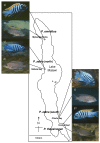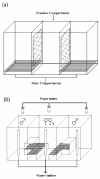Assortative mating among Lake Malawi cichlid fish populations is not simply predictable from male nuptial colour
- PMID: 19265521
- PMCID: PMC2667177
- DOI: 10.1186/1471-2148-9-53
Assortative mating among Lake Malawi cichlid fish populations is not simply predictable from male nuptial colour
Abstract
Background: Research on the evolution of reproductive isolation in African cichlid fishes has largely focussed on the role of male colours and female mate choice. Here, we tested predictions from the hypothesis that allopatric divergence in male colour is associated with corresponding divergence in preference.
Methods: We studied four populations of the Lake Malawi Pseudotropheus zebra complex. We predicted that more distantly-related populations that independently evolved similar colours would interbreed freely while more closely-related populations with different colours mate assortatively. We used microsatellite genotypes or mesh false-floors to assign paternity. Fisher's exact tests as well as Binomial and Wilcoxon tests were used to detect if mating departed from random expectations.
Results: Surprisingly, laboratory mate choice experiments revealed significant assortative mating not only between population pairs with differently coloured males, but between population pairs with similarly-coloured males too. This suggested that assortative mating could be based on non-visual cues, so we further examined the sensory basis of assortative mating between two populations with different male colour. Conducting trials under monochromatic (orange) light, intended to mask the distinctive male dorsal fin hues (blue v orange) of these populations, did not significantly affect the assortative mating by female P. emmiltos observed under control conditions. By contrast, assortative mating broke down when direct contact between female and male was prevented.
Conclusion: We suggest that non-visual cues, such as olfactory signals, may play an important role in mate choice and behavioural isolation in these and perhaps other African cichlid fish. Future speciation models aimed at explaining African cichlid radiations may therefore consider incorporating such mating cues in mate choice scenarios.
Figures


Similar articles
-
Laboratory mating trials indicate incipient speciation by sexual selection among populations of the cichlid fish Pseudotropheus zebra from Lake Malawi.Proc Biol Sci. 2004 Apr 7;271(1540):675-80. doi: 10.1098/rspb.2003.2639. Proc Biol Sci. 2004. PMID: 15209099 Free PMC article.
-
Female preference for conspecific males based on olfactory cues in a Lake Malawi cichlid fish.Biol Lett. 2005 Dec 22;1(4):411-4. doi: 10.1098/rsbl.2005.0355. Biol Lett. 2005. PMID: 17148220 Free PMC article.
-
Colour-assortative mating among populations of Tropheus moorii, a cichlid fish from Lake Tanganyika, East Africa.Proc Biol Sci. 2006 Feb 7;273(1584):257-66. doi: 10.1098/rspb.2005.3321. Proc Biol Sci. 2006. PMID: 16543167 Free PMC article.
-
The diversity of male nuptial coloration leads to species diversity in Lake Victoria cichlids.Genes Genet Syst. 2013;88(3):145-53. doi: 10.1266/ggs.88.145. Genes Genet Syst. 2013. PMID: 24025243 Review.
-
Evolution: love thy neighbour.Curr Biol. 2004 Jun 8;14(11):R419-21. doi: 10.1016/j.cub.2004.05.033. Curr Biol. 2004. PMID: 15182688 Review.
Cited by
-
Don't throw out the sympatric speciation with the crater lake water: fine-scale investigation of introgression provides equivocal support for causal role of secondary gene flow in one of the clearest examples of sympatric speciation.Evol Lett. 2018 Aug 15;2(5):524-540. doi: 10.1002/evl3.78. eCollection 2018 Oct. Evol Lett. 2018. PMID: 30283699 Free PMC article.
-
Colour variation in cichlid fish: developmental mechanisms, selective pressures and evolutionary consequences.Semin Cell Dev Biol. 2013 Jun-Jul;24(6-7):516-28. doi: 10.1016/j.semcdb.2013.05.003. Epub 2013 May 9. Semin Cell Dev Biol. 2013. PMID: 23665150 Free PMC article. Review.
-
Between a Rock and a Hard Polytomy: Phylogenomics of the Rock-Dwelling Mbuna Cichlids of Lake Malaŵi.Syst Biol. 2022 Apr 19;71(3):741-757. doi: 10.1093/sysbio/syac006. Syst Biol. 2022. PMID: 35137239 Free PMC article.
-
Sensory modalities in cichlid fish behavior.Curr Opin Behav Sci. 2015 Dec 1;6:115-124. doi: 10.1016/j.cobeha.2015.11.002. Curr Opin Behav Sci. 2015. PMID: 26693169 Free PMC article.
-
Dimensionality of mate choice, sexual isolation, and speciation.Proc Natl Acad Sci U S A. 2010 Sep 21;107(38):16583-8. doi: 10.1073/pnas.1003537107. Epub 2010 Sep 7. Proc Natl Acad Sci U S A. 2010. PMID: 20823250 Free PMC article.
References
-
- Coyne JA, Orr HA. Speciation. Sunderland, MA: Sinauer Associates Inc; 2004.
-
- Coyne JA, Kim SY, Chang AS, Lachaise D, Elwyn S. Sexual isolation between two sibling species with overlapping ranges: Drosophila santomea and Drosophila yakuba. Evolution. 2002;56:2424–2434. - PubMed
-
- Dominey WJ. Effects of sexual selection and life history on speciation: Species flocks in African cichlids and Hawaiian Drosophila. In: Echelle AA, Kornfield I, editor. Evolution of fish species flocks. Orono, Maine: University of Maine at Orono Press; 1984. pp. 231–249.
Publication types
MeSH terms
LinkOut - more resources
Full Text Sources

